Aechmea mariae-reginae
Click thumbnails for full size, scaled to a new window.
Aechmea mariae-reginae
Species.
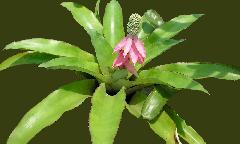
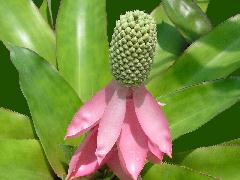
| Female plant. Richard Harper. |
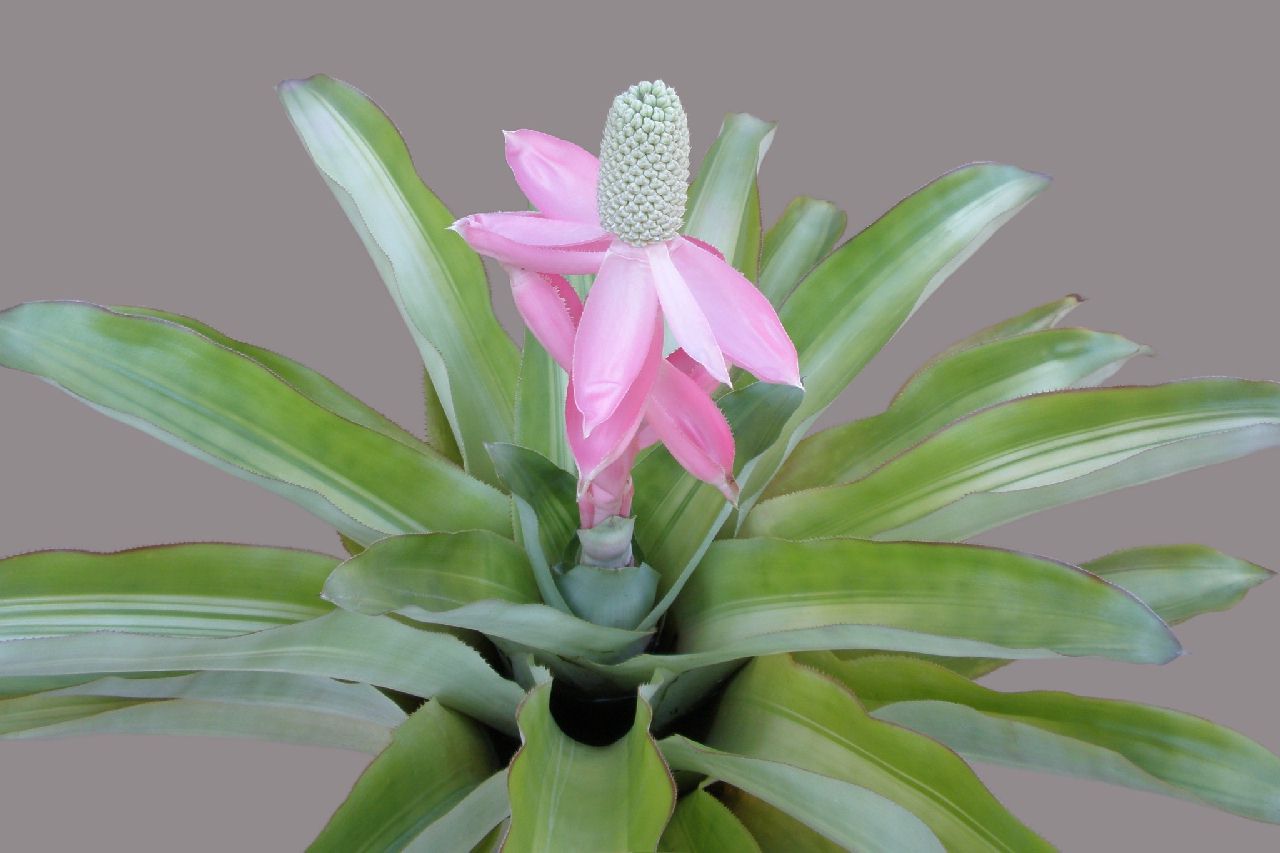
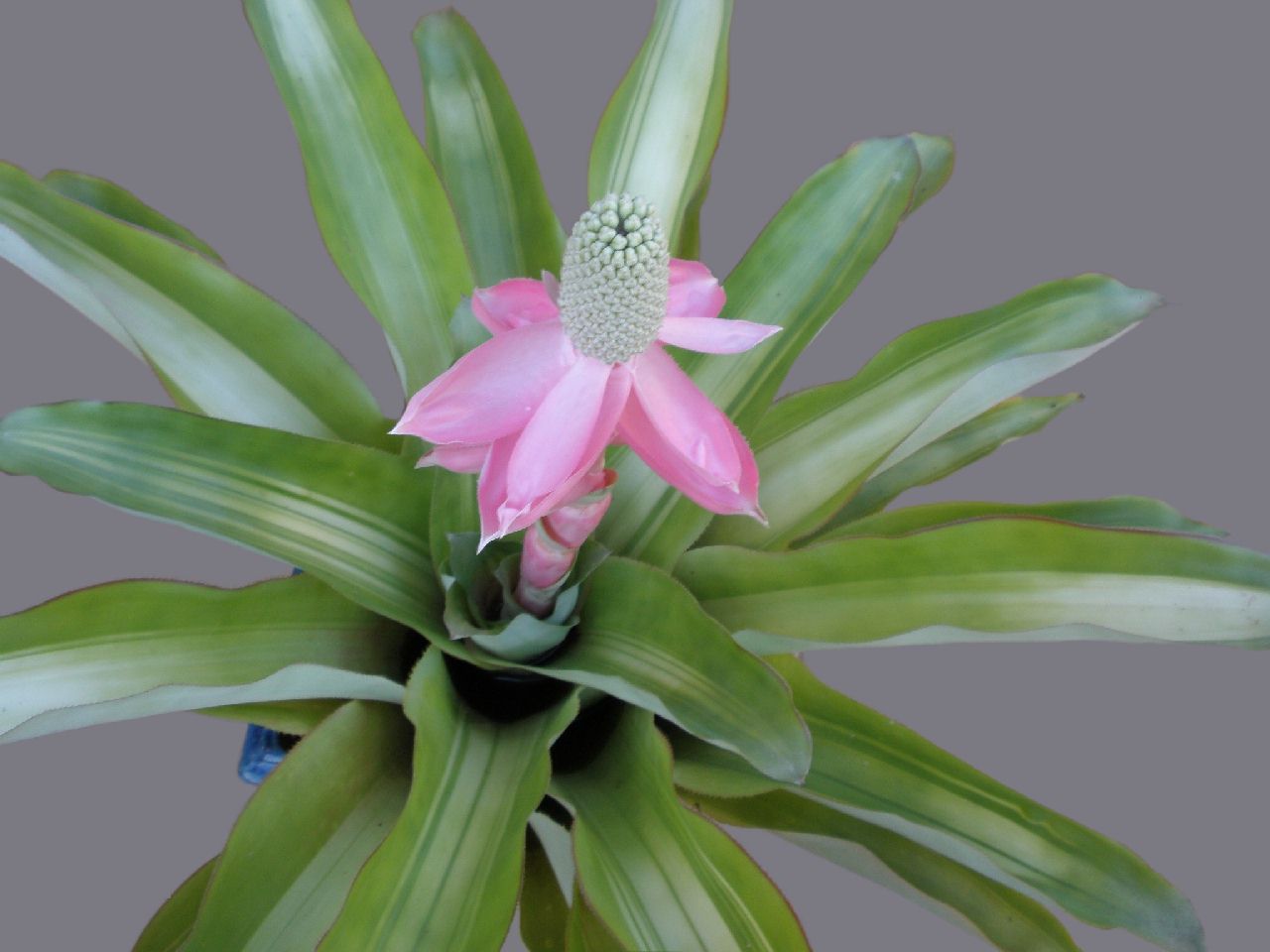
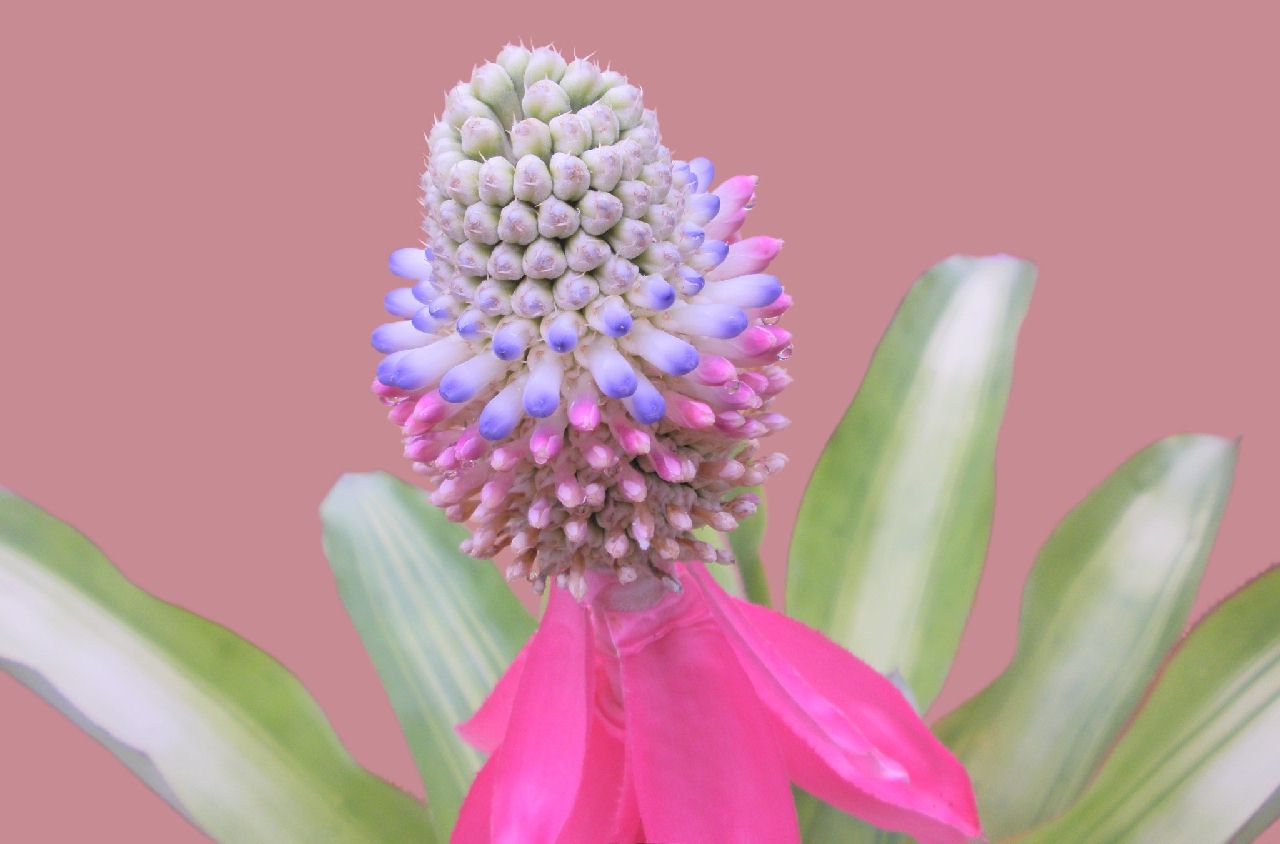
| Female plant (Variegated). Robyn Firth 12/11. |
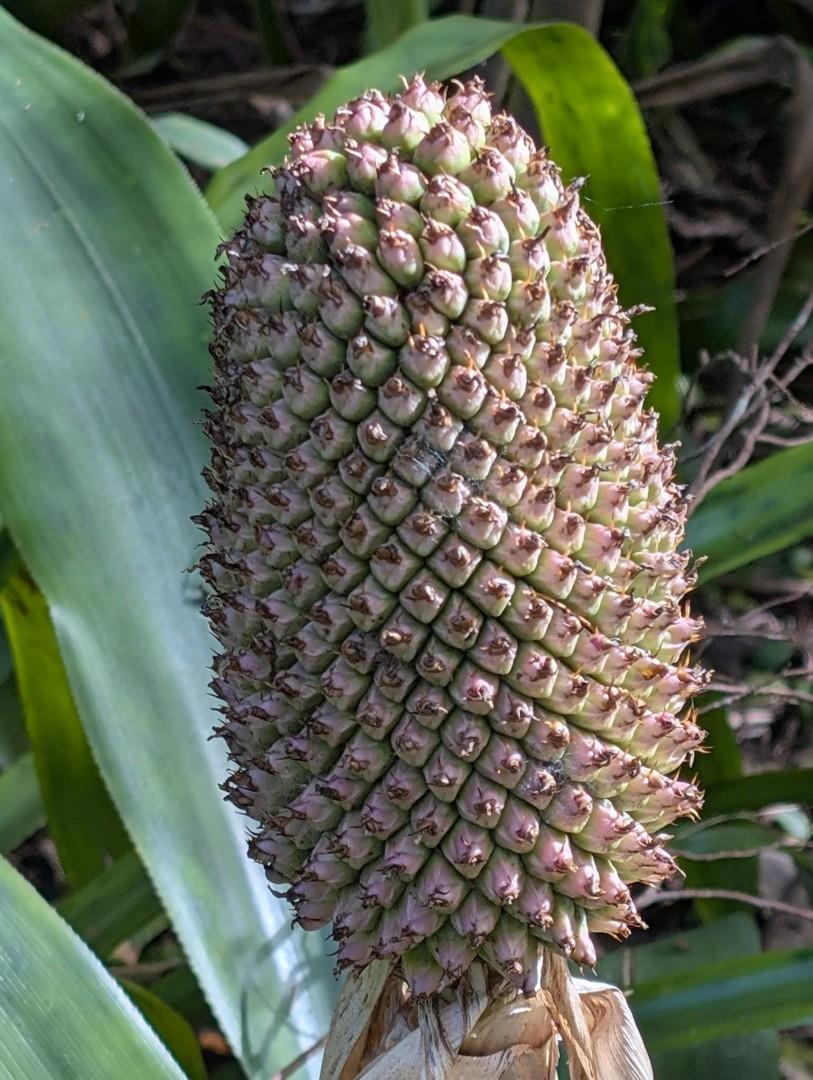
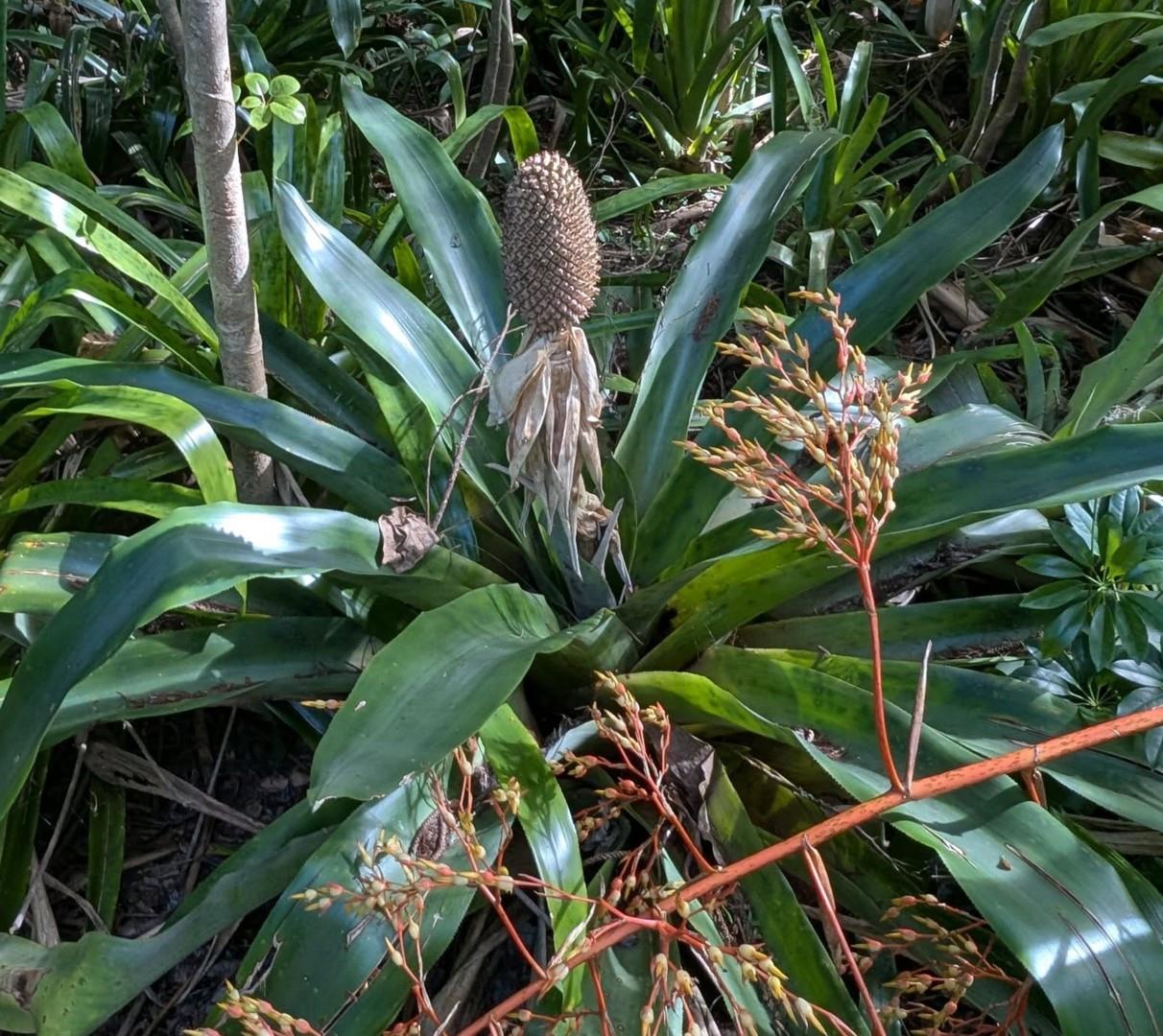
| Mitch Jones 04/25. After flowering, at the Far North Coast Bromeliad Study Group. |
Aechmea mariae-reginae H. Wendland, Hamb. Gartenz. 19: 32. 1863. (staminate).
Aechmea lalindei Linden & Rodigas ex Rodigas, Ill. Hortic 30: 45, pI. 481. 1883. Type. Description and plate. (pistillate.)
Aechmea gigas E. Morren ex C. H. Wright, Bot. Mag. 132: pl. 8107. 1906. Type. Kew Hortus s n (holotype, K; photo GH), cultivated from "Brazil". (pistillate.)
Desc from S&D
Plant dioecious, 4-9 dm high.
Leaves 15-30 in a dense spreading rosette, the outer ones 8-9 dm long, the inner progressively shorter;
Sheaths elliptic, to 16 cm wide, coriaceous, densely and finely brown-appressed-lepidote;
Blades ligulate, subrounded or abruptly acute, apiculate, pungent, 8-10 cm wide, densely and finely appressed-cinereous-lepidote especially beneath, densely serrate with antrorsely curved spines to 3 mm long.
Scape erect, stout, white-farinose;
Scape-bracts reflexed, crowded just beneath the inflorescence, elliptic, acute, 1-2 dm long, densely spinose-serrate, subchartaceous when dry, bright rose, finely appressed-cinereous-lepidote especially beneath.
Inflorescence simple, densely spicate with many-ranked flowers, cylindric, 1-2 dm long, to 53 mm in diameter.
Floral bracts very narrowly triangular, from 4 mm long to almost lacking, membranaceous;
Flowers functionally unisexual, sessile, spreading.
Sepals elliptic with a very large irregular lateral wing overtopping the apex, mucronate, 11 mm long, farinose;
Petals erect, oblong, emarginate, 15-20 mm long, white toward base, blue toward the apex, bearing 2 large, oblong, sparsely fimbriate scales at base;
Stamens equaling the petals, the second series highly connate with the petals;
Ovary obconic; 5 mm long, deeply sulcate, the epigynous tube wanting; ovules borne at the top of the cell, caudate.
Type. Herrenhausen Hortus s n (description), cultivated from Sarapiqui Valley near San Miguel, Costa Rica.
Distribution. Epiphytic and terrestrial in forest, 55-1360 m alt, Costa Rica.
COSTA RICA. Guanacaste: Tilaran, 27 Jan 1926, Standley & Valerio 46335 (US). Limon: La Colombiana Farm of United Fruit Company, Mar 1924, Standley 36957 (US); Cairo, 19 Feb 1926, Standley & Valerio 48870 (US). Heredia: Llanuras de Santa Clara, Apr 1894, J. D. Smith 4960 (GH, US); Feb 1896, 6831 (GH, US). San Jose: "Moravia," Rio Chirripo, 19 Dec 1948, Foster 2710 (US). Cartago: Navarro, Werckle s n (US); Cartago, 1901, Werckle 16202 (S); 21 Jul 1962, Haines 737 (US); Santiago, 22 May 1930. Dodge 7862 (F, GH); Cachi, Rio Naranjo, 15 Oct 1967, Lent 1430 (US).
Australian experience (Butcher)
Female inflorescence 20cm long, 10cm diam
Male inflorescence 40cm long, 8cm diam.
<Aechmea mariae-reginae H. Wendland, Hamb. Gartenz. 19: 32. 1863. (staminate). Detail from J Baker in Curtis Mag. tab. 6441 1879
This is botanically a near neighbour of Aechmea Veitchii, figured in the Botanical Magazine, tab. 6329. The leaves and spikes of the two plants are similar, but here the flower-bracts are reduced to a minimum, and the most effective part of the plant is the large bright red reflexing bract-leaves of the general peduncle. The present plant is a native of Costa Rica, where it is used at the feast of Corpus Christi for the decoration of the altars in the churches. Its local name is "Flor de Santa Maria", from which the scientific name has been taken. It has been in cultivation in Europe for nearly twenty years, but only flowered with Messrs. B.S. Williams and Co., at Holloway, in April of this present year.
DESCRIPTION
Leaves fifteen to twenty in a sessile utricular rosette, lorate-lanceolate, two or three feet long, three or four inches broad at the dilated ckasping base, two or three inches in the middle, subcoriaceous in texture, thinly white lepidote on both sides, especially on the under surface, narrowed gradually to a cuspidate tip, margined with crowded lanceolate small spreading brown prickles, which grow gradually less from the base of the leaf upwards. Peduncle about a foot long, stout, stiffly erect, clothed throughout with thin white lepidote tomentum, furnished with numerous reflexing persistent crimson lanceolate bract-leaves with toothed margins. Flowers in a dense oblong spike three or four inches long, each subtended by a minute lanceolate membranous bract. Calyx including the ovary half an inch long, clothed throughout with white tomentum; sepals about as broad as long, oblique, much imbricated, furnished with a large pungent cusp. Petals lingulate, half an inch long, blue when they first open, turning red as they fade, furnished each with a pair of minute fimbriated scales at the base. Stamens and pistil reaching to the summit of the sepals – J G Baker
Illustration
Figs.1 and 2 entire flowers – life-size; fig.3 a calyx-segment, of unusually irregular form; fig.4 a petal and a couple of stamens; fig.5 two anthers, showing their insertion on the filament; fig.6 stigmas and summit of style; fig.7 horizontal section of ovary; - all more or less enlarged
2010 Butcher's note: If this is the same as the Wendland specimen then Smith treats this as a staminate plant and yet to me both stamen and stigma seem functional as drawn. Thus Aechmea mariae-reginae is trioecious in line with several Catopsis which Smith also missed.
Aechmea gigas E. Morren ex C. H. Wright, Bot. Mag. 132: pl. 8107. 1906.
Type. Kew Hortus s n (holotype, K; photo GH), cultivated from "Brazil". (pistillate.)
The plant here figured was purchased from the widow of the late Prof. E Morren of Liege and flowered in the Victoria House at Kew for the first time in March last. No description was ever published by Prof. Morren, but there exists amongst his drawings at Kew a life-sized figure by P. Stroobant of a plant which flowered in November, 1881. Ae. Lalindei, Linden & Rodigas (Ill Hort vol.xxx. t.481), to which this species is united by Mr. Baker, is a very close ally from New Granada, of which perfect flowers are not known. Mez (in DC. Monogr. Phan. vol. ix. p. 263) does not agree as to the identity of these two species, but suggests that our plant belongs to the section Chevalliera; it seems. However, to connect that section with Pothuava, in having the inflorescence of the latter without large bracts subtending each flower, while the angular ovary is that of the former. Ae. Mariae-Reginae, H Wendl. (Bot. Mag. t. 6441) is another allied species, but with a longer, narrower spike, and narrower bracts.
Since flowering the plant at Kew has produced two healthy offsets. The original plant was sent to Prof. Morren by Dr. A. Glaziou of Rio Janeiro, and is presumably a native of Brazil.
DESCRIPTION.
Acaulescent. leaves about sixteen in a tuft, lorate, shortly acuminate, sheathing at the base, three feet long, five inches wide, nearly glabrous above, white furfuraceous beneath; spines at the centre of the leaf three lines apart and straight, the lowermost decurved, the uppermost upcurved. Peduncle nearly a foot long; bracts dentate, the lower imbricate, with a crimson, elliptic, inflated sheath and a green, ovate-acuminate blade, the uppermost rosulate, ovate, crimson, five inches long, two and a quarter inches wide; spike oblong, five inches long, two inches wide. Calyx rigid, white, lepidote outside; lobes four lines long, suborbicular, concave, shortly awned. Corolla shortly exserted, pale green; petals seven lines long, a line and a half wide, narrowly oblong, emarginate, with two fimbriate scales at the base. Stamens inserted about half-way up the corolla; anthers oblong, mucronate, about twice as long as the filaments. Style shortly three-lobed. Fruit three to six angled, white lepidote, green below, pale rose and pyramidal above, an inch and a quarter long, crowned by the spreading awns of the persistent sepals – C H Wright
Illustration Fig.1. portion of calyx and pistil; 2, portion of corolla laid open; 3. anther; 4. apex of style; 5. whole plant; - 1-4, enlarged; 5. much reduced
Aechmea lalindei Linden & Rodigas ex Rodigas, Ill. Hortic 30: 45, pI. 481. 1883. Type. Description and plate. (pistillate.)
AICHMEE DE LALINDE
CARACTERES GENERIQUES – Bracteae sub singulo flore cyathiformes. Perigonii superi sexparti laciniae exteriores calycinae aequales spiraliter convolutae aristatae vel muticae apice hinc oblique dilatatae, interiores petaloideae exterioribus multo longiores inferne convulatae basi intus squamosae vel rarius nudae. Stamina six, imo perigonio insertae; filamentis filiformibus, tribus laciniarum interiorum basi adnatis; antheris ovatis dorso affixis subincumbentibus. Ovarium inferum triloculare; ovulis plurimis e loculorum angulo centrali pendula anatropa. Stylus filiformis; stigmatibus 3 linearibus vel petaloideis spiraliter convolutis. Bacca ovato subglobosa trilocularis. Semina plura ex apice loculoram pendula, testa coriacea fusca, umbilico filo brevi gracili appendiculato. Embryo minimus rectus in basi albuminis denso farinacei, extremitate radiculari umbilicum attingente supera.
Herbae Americae tropicae saepe in arborum truncos pseudoparasiticae, foliis radicalibus ligulatibus vel ensiformis vrassis coriaceis integerrimis vel spinuloso-serrulatis, scapo ramoso paniculato, rachi flexuosa, bracteis spinoso-aristatis integerrimis vel tricrenaris, floribus terminalibus abortivis.
Aechmea Ruiz et Pav., Prodrom. 17. t. 8; Lindl., Botan. Reg. t. 1068; Endlich. Gen. Pl. 1301.
CARACTERES SPECIFIQUES – Foliis latissimis concavis acutis rigidis, margine acute breviter denticulatis, numerosis circiter 30, 1.5 metro longis; inflorescentia gigantea, scapo squamis diridbus lanceolatis involuto; rachi cylindrico rubro, bracteis numerosis latis inermis lanceolatis reflexis intense rubris; sepalis albidis apice roseo tinctis.
In Nova Granata legit illustrissimus Lalinde cui plantam dicamus.
Depuis plus de trois mois, les visiteurs de l'Etablissement de la Compagnie continentale ont eu l'occasion d'admirer la brillante inflorescence d'une de ces Bromeliacees au port majestueux et a l'aspect grandiose, au feuillage ample et colossal, qui font songer immediatement aux Tropiques, leur patrie. La belle planche ci-jointe donne le portrait fidele de cette inflorescence, telle qu'elle est encore a l'heure ou vont paraitre ces lignes. Les nombreux boutons, bien au dela d'une centaine, qui terminent la hampe, doivent s'epanouir encore, et c'est seulement apres leur evolution complete qu'il sera permis de determiner cette plante en parfaite connaissance de cause. En attendant que ce travail soit fait par le savant bromeliographe M. Ed. Morren qui a bien voulu nous le promettre, nous nous bornons a presenter cette brillante espece aux lecteurs de l'illustration sous le nom d'Aechmea Lalindei en souvenir d'un eminent amateur de plantes, M. Lalinde, qui habite dans la Nouvelle Grenade d'ou il envoya l'espece a M J Linden in 1867
Cet espece est fort grande; elle a 1.50m de haut sur 3.00m de diametre. Les feuilles au nombre d'une trentaine ont de 0.12m a 0.17m de large et sont disposees en immense rosace; elles sont dressees, rigides, gracieusement reflechies, longues de 1.50m, engainantes, au limbe borde de petite epines vertes; ces feuilles sont d'un beau vert, sauf les superieures qui, de plus en plus reduites, passent aux spathes de la hampe don't elles prennent aussi la coloration rouge. L'inflorescence dressee depasse le niveau du feuillage; la hampe cylindrique est revetue de spathes lanceolees, terminees en pointe, les superieures grandes, larges et allongees et repliees sur la hampe; leur coloration est du plus beau rouge. Les fleurs sont disposees en epi serre, en spirale, tres nombreuses. Les boutons, blanc verdatre, ont le sommet rose violace.
La plante ne demande aucun soin particulier; elle vient parfaitement en serre chaude en terreau leger et fibreux. – Em. Rodigas
Translated by Butcher
For more than three months, visitors to the Continental Company establishment had the opportunity to admire the brilliant inflorescence of one of these Bromeliads in its majestic bearing and imposing aspect, with the ample and huge foliage, that makes you immediately think of the Tropics, their homeland. The beautiful enclosed illustration gives a faithful portrayal of this inflorescence, which we can see for the first time in outline. The numerous buds, well beyond a hundred, that completes the stem, must bloom again, as it is only after their complete development that perfect reasoned knowledge can be determined for this plant. Until this work is made by the scholarly bromeliograph Mr. Ed. Morren who has promised his assistance, we limit ourselves to present this brilliant species illustration to our readers under the name of Aechmea Lalindei in remembrance to an eminent amateur of plants, Mr. Lalinde, who lives in New Grenada from where he sent the species to M J Linden in 1867.
This species is very big; it is 1.50m high and 3.00m diameter. The leaves numbering about thirty, are 0.12m to 0.17m long and are arranged in immense rosette; they are erect, rigid, gracefully reflexing, 1.50m long, with sheaths, with small green thorns along the edges of the blades; these leaves are a beautiful green, except the upper ones that, more and more reduced, passing to the spathes of the stem but do not take on the red colouration. The erect inflorescence exceeds the level of foliage; the cylindrical shaft is donned with lanceolate spathes, ending in a tip, the large, wide and stretched out upper ones are folded on the stem; they are the most beautiful red. The flowers are arranged in a dense spike, in spiral fashion and very numerous. The bud, white greenish, have a purplish pink top.
The plant does not need any particular care; it grows perfectly in a hot greenhouse in light and fibrous compost.
- Em. Rodigas
Updated 19/04/25






